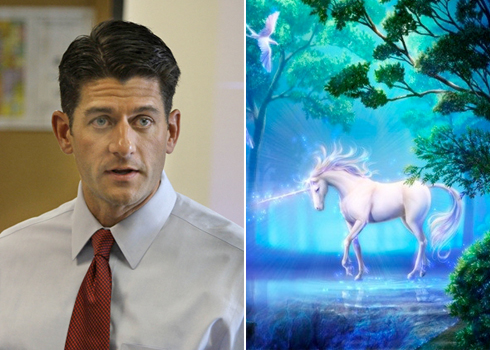2.8% unemployment? $150 billon a year in new economic growth? Tax revenues that rise with tax cuts?
All this can be yours — and more! — even while cutting trillions of dollars from the federal government and lowering taxes on the wealthy and corporations, according to a giddy estimate of the Republican budget by the conservative Heritage Foundation. Even as Rep. Paul Ryan (R-WI) proudly touted his “fact-based budget” and decried Democrats’ “budget gimmicks” yesterday, he prominently cited the think tank’s absurdly rosy numbers, drawing widespread mockery from economists, budget experts, and health care wonks. Even the developer of the model that Heritage used to crunch the numbers can’t figure out how Heritage reached its conclusions.
“The Heritage numbers are insane,” MIT economist Jonathan Gruber said in an interview with TPM.
As Paul Krugman put it, Heritage’s take “depends an awful lot on unicorn sightings — a belief in the impossible.”
The numbers stand in stark contrast to analysis from the independent Congressional Budget Office, the gold standard used by both parties to determine the costs of legislation, which shows an increase in the deficit’s share of the economy in the plan’s first decade thanks to its massive tax cuts and then much tougher financial burdens for seniors in future decades as their health care benefits dwindle.
“CBO is what they use on the budget side — as a matter of procedure, any numbers from the Heritage Foundation or anybody else are essentially worthless,” Bruce Bartlett, a former Treasury official under President George H.W. Bush, said in an interview. “You can assert whatever you want to assert, but you can always find some half-baked tax think tank that will make up any number you feel like.”
“The idea he’d go to Heritage for that kind of support indicates he didn’t like what the CBO was going to tell him,” Stan Collender, a former budget aide for both the House and Senate, told TPM. “This is the same guy who said his budget has no gimmicks in it turning to the rosiest scenario he could get.”
Dean Baker, co-director of the Center for Economic and Policy Research, pointed to the projections in the Ryan plan that unemployment would decline by 2% in 2012 as fishy even on their own terms.
“I think they just misprogrammed it,” he told TPM. “Note that the unemployment rate falls by 2.1 percentage points relative to the baseline in 2012 even though they only created an extra 900,000 jobs. That doesn’t make any sense.”
By 2021, unemployment would hit 2.8% under their projection, well below the 5% – 6% range that the Federal Reserve considers the maximum desirable rate achievable without dangerous inflation.
The Heritage analysis bases its numbers on a “dynamic” model that it says takes into account the explosive growth unleashed by tax cuts. As a number of commentators have noted, it’s the same approach that led them to conclude the Bush tax cuts would reduce the deficit and create millions of new jobs — instead they exploded the deficit and unemployment worsened, eventually skyrocketing.
But the model they use, which they attribute to analyst IHS Global Insight, appears to be out there even according to its creators. Nigel Gault, the chief economist for Global Insight told the National Journal‘s Tim Fernholz that he has no idea how Heritage came up with their conclusions.
“I’m not quite sure what assumption … would deliver 2.8 percent unemployment,” Gault said. “We might assume different parameters.”
TPM reached out to the Heritage Foundation study’s authors to ask about some of the criticism’s of their analysis, but did not immediately receive a reply.






